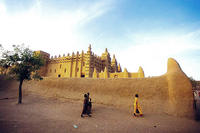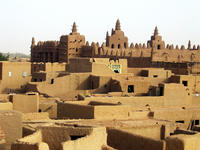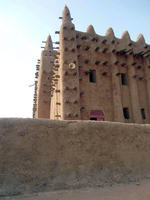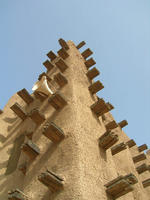You are in: Africa -> Mali -> Old Towns of Djenné, and traditional search or Image Gallery will yield results of this site only
Old Towns of Djenné
| Site number: | 116 |
|
| Type of site: | Heritage in danger | |
| Date: | 250BC-15/16th c | |
| Date of Inscription: | 1988 | |
| Location: | Africa, Mali, Djenné Circle, Region of Mopti | |
Up to 75 images are shown here. Click on each for more details or on Image Gallery for more images.
Six official UN languages:
Arabic,
Chinese,
English,
French,
Russian,
Spanish
Other languages: Bulgarian, Dutch, Esperanto, Estonian, Farsi, German, Italian, Japanese, Norwegian-bokmål, Polish, Portuguese, Swedish
Other languages: Bulgarian, Dutch, Esperanto, Estonian, Farsi, German, Italian, Japanese, Norwegian-bokmål, Polish, Portuguese, Swedish
| Description: | Djenné has been inhabited since 250 B.C., and has since become a market centre and an essential link in the gold trade of the trans-Sahara. It became one of the centres for the spread of Islam in the 15th and 16th centuries. Protecting the inhabitants from the seasonal floods the site’s traditional houses have been built on hillocks (toguere), today almost 2,000 of these houses are still standing. --WHMNet paraphrase from the description at WHC Site, where additional information is available. | |
| Djenné (also Dienné or Jenne) is a historically and commercially important small city in the Niger Inland Delta of central Mali. It is just west of the Bani River (the Niger River passes well to the west and north). It has an ethnically diverse population of about 12,000 (in 1987). It is famous for its mud brick (adobe) architecture, most notably the Great Mosque of Djenné, originally built in 1220 and rebuilt in 1907. In the past, Djenné was a centre of trade and learning, and has been conquered a number of times since its founding. Its historic city center was designated a World Heritage Site by UNESCO in 1988. Administratively it is part of the Mopti Region. --Wikipedia. Text is available under the Creative Commons Attribution-ShareAlike License. | ||
| Source: | http://whc.unesco.org/en/list/116 | |
| Source2: | http://whc.unesco.org/en/list/116/video | |
| Reference: | 1. UNESCO World Heritage Center, Site Page. | |


























